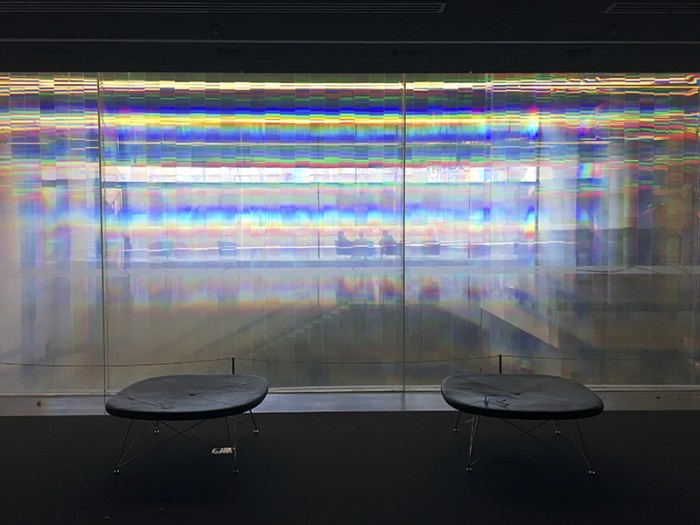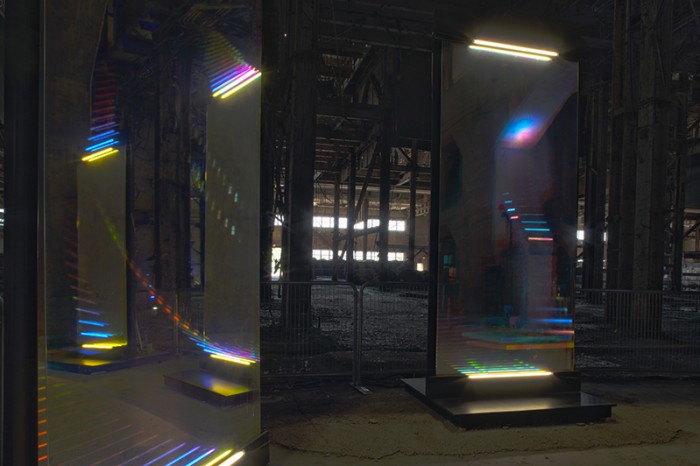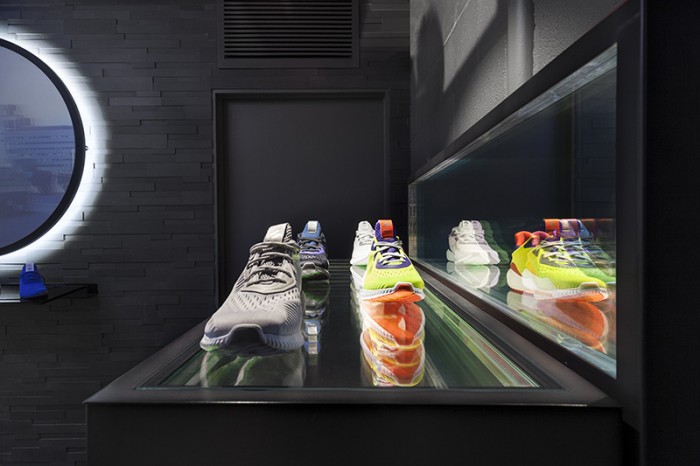In Conversation with…Jordan Söderberg Mills
With Glass the material of focus for this month I took the opportunity to have a chat with Jordan Söderberg Mills, an interdisciplinary artist working in installation, sculpture, design objects and an all round glass aficionado.

Photo Credit: Devin Lund
His work is beguiling, at once visually arresting and yet sits on the very edge of our visual perception; twisting the borders of the physical and digital realities in the process.
Born in Ontario, Canada, he originally studied Art History at Trinity College at the University of Toronto, followed by Architecture at the Universidad Diego Portales, in Santiago, Chile. In his own words he was a “terrible student,” and completed neither course. His career took a more focused turn when apprenticing as a blacksmith with master sculptor Francisco Gazitua in the foothills of the Andes. Since then he has completed a Master’s Degree at Central Saint Martins in London, and big projects have followed. Whilst he splits his time between his self designed and built steel-framed studio nestled alongside (a highly flammable) Eucalyptus forest in Chile and his native Toronto I was lucky enough to catch him on one of his fairly frequent trips to the UK to find out more about how he works.
From blacksmith to working with glass – how did that occur? When did you start using glass?
In some ways, these materials behave in a similar manner. Steel is a shadow, while glass is light – they’re opposite ends of a spectrum. They’re formed and manipulated with tremendous amounts of heat, are incredibly plastic with the right kinds of tools. There’s this cosmological aspect to these materials – iron all comes from exploding stars, and glass lenses have unlocked some of the mysteries of the universe. They both catch light in their own way, which I’m drawn to. I began creating steel structures to cast shadows, but decided to focus on bending light itself, which glass does brilliantly.

Photo Credit: Devin Lund
Your work has a real sense of amplifying the ‘magical’ properties of glass; hard but transparent and yet reflective, which makes us question our own sense of perception. How do you approach material research and project development? Is there a specific aim or is it more about experimentation?
My material research starts with understanding light – its physical properties, how it can be unwoven, and put back together. I layer different materials to capture light in novel ways – refract, diffuse, and reflect it back into the eye. This is a big part of my process – sourcing materials from unusual places – often used in scientific analysis, or the aerospace industry, for example, and seeing how these things play with light. I’ll talk to the manufacturers and convince them (i.e. beg them) to modify their processes in subtle ways to create new kids of effects, new kids of materials.
The work is all about the perceptual phenomenon. Once I figure out what these materials can do, it’s about scaling the work up or down – to use as a camera lens, for example, or the substrate for a gigantic waterfall. Playing with iteration and scale usually dictates what the object or experience will be. Marijuana is also legal in Canada, which helps the creative process.
How do feel about the relationships between function and aesthetic, art and design? Are such definitions important to you? Where does your work sit?
My background is in both sculpture and design. Many people see these as mutually exclusive, but I don’t. Technically, art isn’t supposed to be useful, and design should only be about the user. I find both extremes a little boring. Objects can have narratives, be concept-driven, and push aesthetic and perceptual boundaries. Art can be about craft, technique and have some measure of “purpose” outside of being physical or experiential concepts. There are creatives that transgress this boundary – Donald Judd, Isamu Noguchi, Tokujin Yoshioka, all of whom are an inspiration to me. Working with light, or mirror, or installation, tends to fall between art and design categories. It’s about creating beautiful things that play with space, with concept, with subjective experience, with materiality.
Your work evokes both the physical and digital – would you say you align yourself with the ‘Phygital’ world?
I often look to CGI inspiration – rare, improbable landscapes in RPGs, exploding tesseracts, swirly orbs from evil wizards.
Digital artefacts can be manipulated in any way, completely ignoring the laws of physics. I find it interesting to approach physical objects in a similar manner, but with the limitations of the real. It’s possible to create new kinds of physical things within these boundaries, if you treat light as data, and the eye as a receiver. A lot of my work appears to be photoshopped for this reason – because I’m acknowledging physical parameters but pushing how light expresses, much like a digital artifact.
What do you see the future of glass including? Any insights into new developments or trends that you’re seeing develop through your own research?
Every translucent surface will be personal screen, interacting with your own wearable tech. Augmented reality will create a phygital palimpsest over everything, once the Google Glass team realizes people don’t want to look like cyborgs that is! We’ll be using wearable glyphs to hide our identities or alter our self image through the cameras that will be streaming everywhere.
Volumetric displays are coming, as are “solid light” displays using standing waves and tiny, firefly LEDs. Once we have translucent photovoltaics (I think we’re pretty close, now,) we’ll be generating localized power from building envelopes, automobiles, and wearable tech.
It certainly seems to be working, you’ve been super busy over the last couple of years, how have you found it?
My big break was exhibiting with FRAME magazine at Salone del Mobile in Milan a couple of years ago. Since then I’ve done projects for Tate Britain, Clerkenwell Design Week, and the Istanbul Biennale. Last year I created a retail space for Adidas in Boston, Massachusetts with Sid Lee Architecture. I’m currently developing music videos, sets for a certain rapper who can’t be named, and a big mirror installation for the Art Gallery of Ontario. So there’s even more to come!

Photo Credit: Maxime Brouillet
And you were recently awarded the Wallpaper Best use of Glass 2018 award – you must be stoked! How did the judges make their decision – was it a submission, or based on one piece of work? Or were they looking at your entire portfolio?
That was, pardon my language, kookoo bananas. I had no idea it was coming, didn’t apply for it, and didn’t realize they were looking at my work at all. I was very, very happy about it, and it was a big surprise. It goes to show you that you don’t need to be backed by a big studio, or to have buckets of investment capital to create interesting things (I certainly do not.)
I had an email out of the blue asking me to mail them a mirror. I almost didn’t do it because shipping to the UK from Canada is bloody expensive. Very, very glad I did at the end of the day. Pretty sure it made my mum cry…in a good way!








Comments
Great article on wonderful work /artist. I founded to be inspiring intriguing and informative.